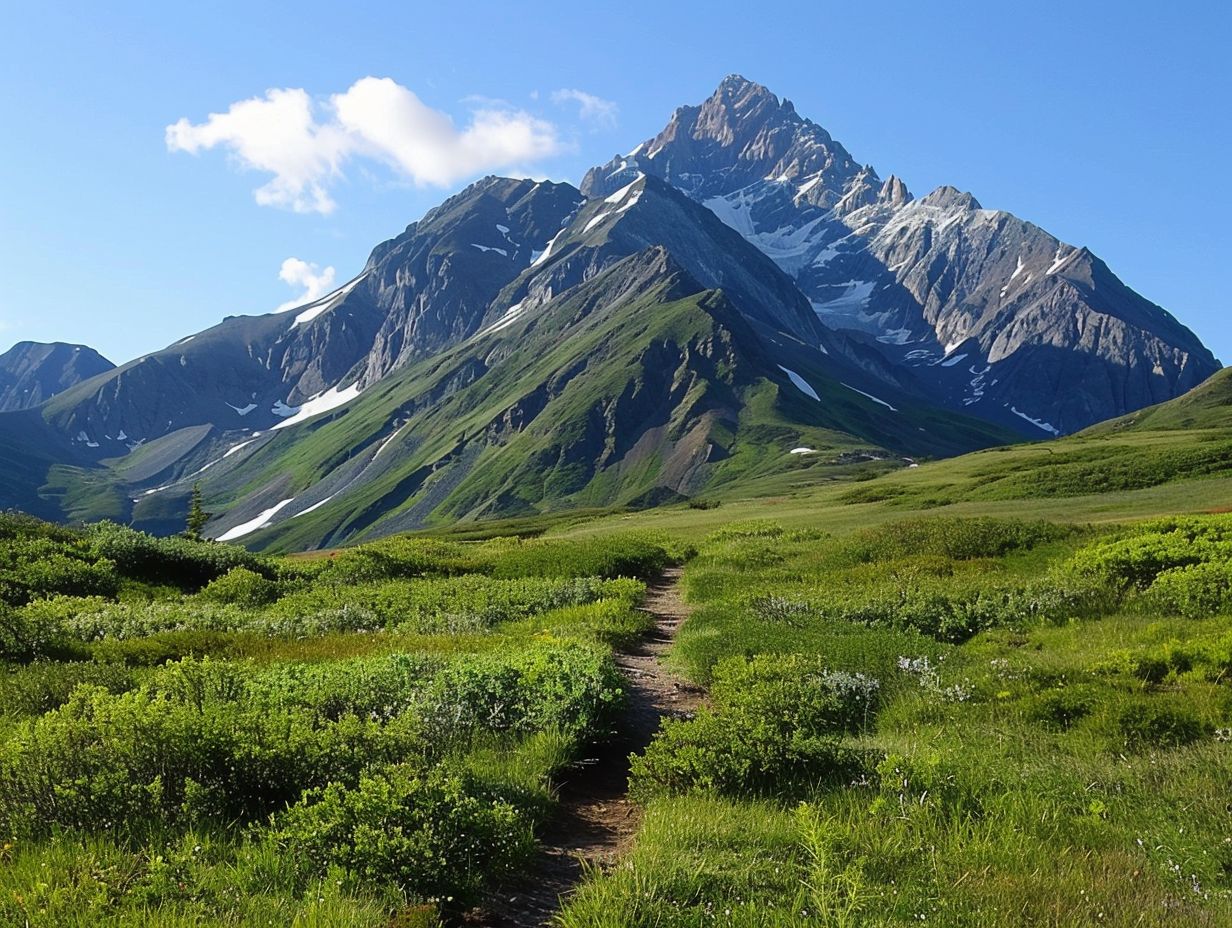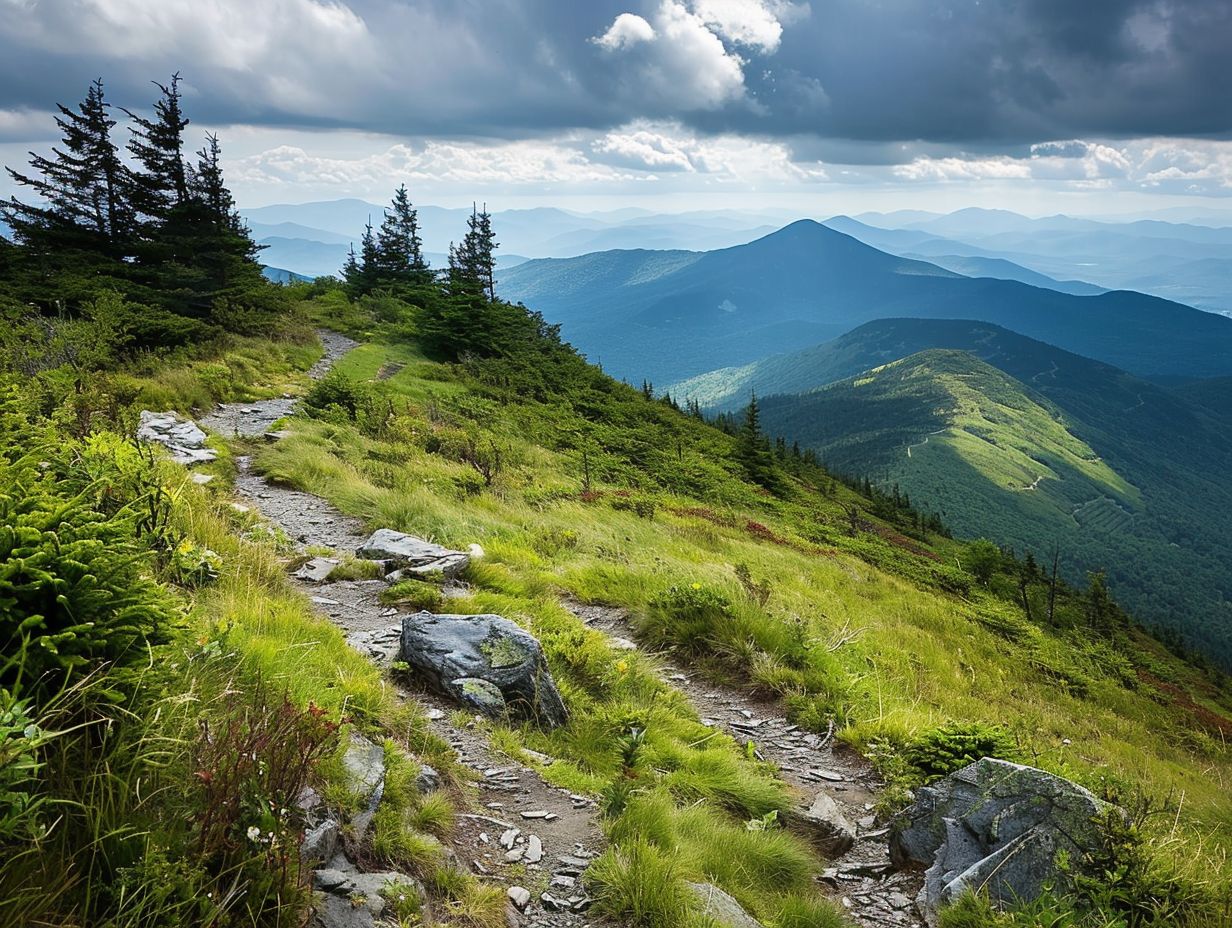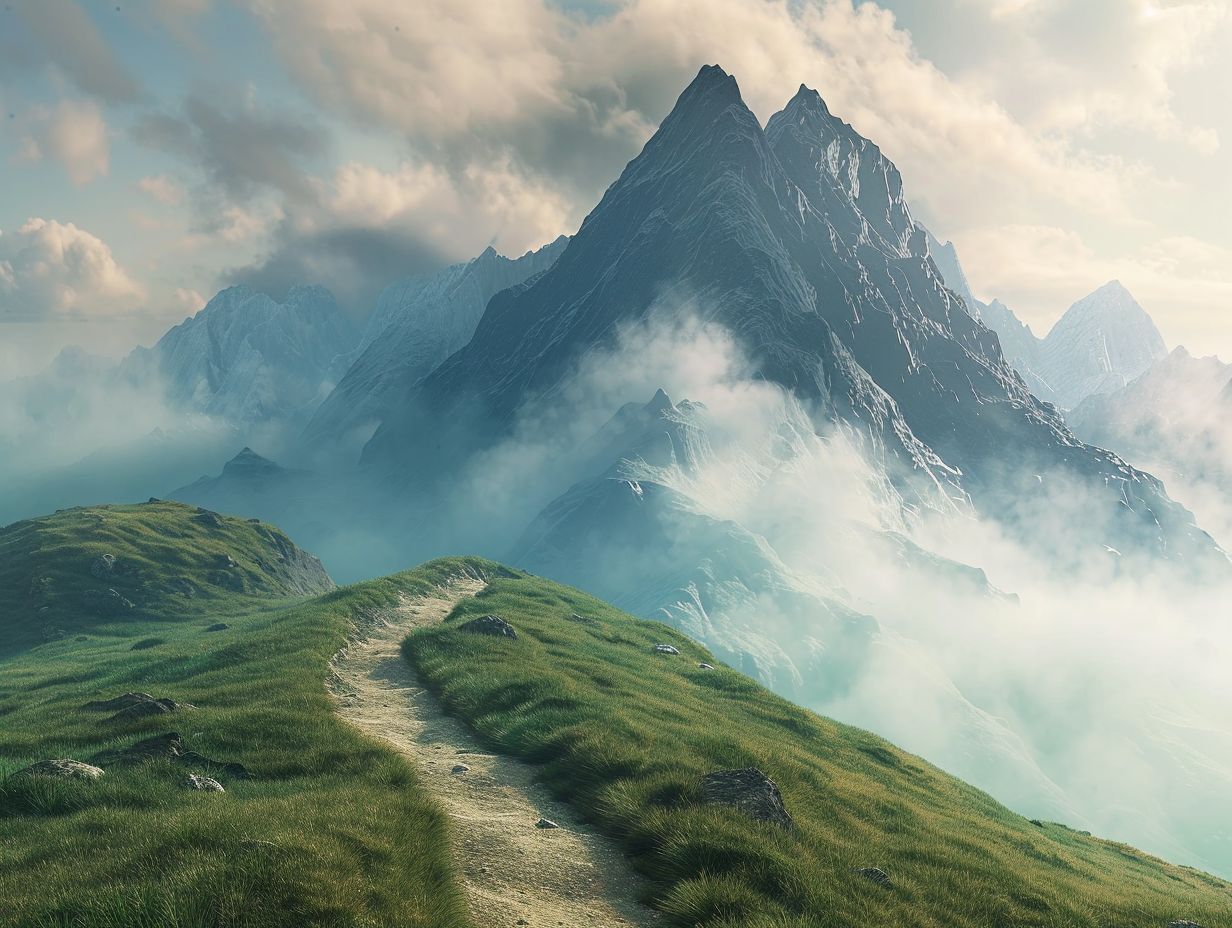Have you ever wondered what Munros are and why individuals are enthusiastic about ascending them?
This introductory guide to climbing Munros delves into the definition and origin of Munros, the advantages of ascending them, methods for preparing physically and mentally for a Munro climb, necessary equipment to carry, considerations when selecting the appropriate Munro to ascend, safety recommendations, and proper etiquette to adhere to while in the mountains.
Prepare yourself for an exhilarating journey in the Scottish Highlands!
Key Takeaways:

- Climbing Munros, or mountains in Scotland over 3,000 feet, offers stunning views and a sense of accomplishment.
- Proper physical and mental preparation, essential gear, and safety precautions are important for a successful Munro climb.
- Choosing the right Munro to climb and showing respect for nature and fellow climbers are key elements of enjoying the experience.
What are Munros?
You may be familiar with Munros, a group of mountains in Scotland renowned for their height and level of difficulty. There are over 280 peaks classified as Munros, a term originating from Sir Hugh Munro, who initially compiled a list of these majestic peaks in the Scottish Highlands.
These mountains are not only respected for their impressive height but also for the stunning landscapes they offer to climbers and hikers. To be classified as a Munro, a mountain must be at least 3,000 feet (914.4 metres) tall and have a prominence of at least 150 metres.
This criteria attracts outdoor enthusiasts in search of adventure and remarkable views. Sir Hugh Munro’s list, published in the early 20th century, sparked a strong interest in peak-bagging throughout the Scottish Highlands, with many individuals embracing the challenge of conquering these iconic summits.
Definition and History
The term “Munros” refers to a specific group of peaks in Scotland, each of which stands taller than 3,000 feet. These mountains are historically significant in the realms of mountaineering and outdoor adventure, drawing hikers and climbers from various corners of the globe to experience the rugged landscapes of the Scottish Highlands.
Named in honour of Sir Hugh Munro, who catalogued these peaks in 1891, Munros have become a cultural icon both in Scotland and worldwide. The classification of Munros is based not only on height but also on the prominence and uniqueness of each peak.
Currently, there are 282 Munros, with numerous passionate outdoor enthusiasts striving to summit all of them – a pursuit commonly referred to as Munro bagging. This activity has evolved over time, with individuals establishing personal objectives to conquer these awe-inspiring mountains, forging a special connection between people and nature while celebrating Scotland’s rich mountaineering legacy.
Why Climb Munros?
Engaging in the activity of Munro bagging can provide a highly gratifying experience for both novice walkers and those with more experience, as it offers a strong sense of achievement upon successfully reaching the summits of these renowned Scottish peaks.
The stunning panoramas and challenging trails associated with Munro bagging have established it as a sought-after outdoor pursuit among individuals who appreciate adventure.
For individuals who are new to rambling, Munros present an excellent opportunity to start their journey into this recreational activity.
This allows them to push their boundaries and enhance their confidence in outdoor pursuits. With a variety of paths available that cater to different levels of expertise, Munros ensure that there is something suitable for everyone, ranging from leisurely strollers to experienced climbers.
Well-known Munros such as Ben Nevis and Glen Lednock showcase the varied terrain and natural beauty these mountains possess, appealing to walkers in search of both physical challenges and awe-inspiring landscapes.
Benefits and Rewards
When you conquer Munros, you not only benefit from the physical exercise but also gain access to unparalleled views of the Scottish landscape from elevated points. Peaks like Ben Nevis and Glen Lednock present hikers with panoramic vistas that exhibit the beauty and grandeur of Scotland’s natural surroundings.
These majestic Munros not only offer climbers stunning scenery but also foster a sense of accomplishment as they ascend these iconic peaks. Standing atop Ben Nevis, the highest mountain in the British Isles, you are treated to an awe-inspiring view of the rugged Highlands sprawling below you.
Similarly, taking in the sights from Glen Lednock provides a contrasting yet equally captivating experience, with its rolling hills and tranquil lochs forming a picturesque backdrop that encapsulates the essence of Scotland’s allure.
Preparing for a Munro Climb

Before setting out on a Munro ascent, it is essential for you to engage in proper preparation. This involves a combination of physical fitness, ensuring you have appropriate equipment, maintaining awareness of safety protocols, and possessing basic navigation skills. Investing time in training and readiness can greatly enhance your overall hiking experience and ensure a safe and enjoyable journey through the Scottish Highlands.
To develop the necessary physical fitness needed for a Munro ascent, it is advisable to engage in regular cardiovascular and strength training to get ready for the challenging terrain.
Moreover, having essential equipment such as robust walking boots, waterproof clothing, a map, compass, and emergency supplies is vital for ensuring safety in the ever-changing mountain conditions.
Giving priority to safety measures, like checking weather forecasts, informing a trusted person of your route, and acquainting yourself with emergency procedures, can help avoid unexpected incidents.
Finally, mastering basic navigation skills using maps, compasses, or GPS devices is crucial for staying on course and preventing the danger of getting lost in the vast wilderness of the Munros.
Physical and Mental Preparation
In preparing for a Munro climb, you must focus on both physical and mental readiness as these mountains pose various challenges that demand strength and resilience. Ensure you have the appropriate clothing to withstand Scotland’s unpredictable weather and mentally prepare yourself for the demanding yet fulfilling journey ahead.
Selecting the right gear is paramount, ranging from waterproof jackets to sturdy hiking boots that offer solid ankle support on rough terrain. The mental strength required to overcome fatigue and uncertainty is crucial, given that the ascent is physically and mentally taxing.
It is imperative to maintain focus, break down the climb into manageable sections, and uphold a positive outlook. Handling obstacles like fatigue, changes in altitude, and harsh weather conditions demands mental toughness and flexibility to guarantee a successful and secure Munro climbing endeavour.
Essential Gear for Munro Climbing
Having the right gear is essential for Munro climbing to guarantee your comfort, safety, and success throughout your journey. Essential equipment like sturdy hiking boots, waterproof clothing, navigation tools, and emergency supplies lay the groundwork for a well-prepared hiker’s kit when facing the demanding Scottish peaks.
When selecting hiking boots, choose ones that offer ankle support and a secure grip to navigate diverse terrains effectively. Waterproof attire, such as a high-quality rain jacket and trousers, is vital for staying dry in the unpredictable mountain weather. Navigation tools like maps and compasses are crucial for planning your route and staying on course during your hike.
It is also critical to have a well-equipped first aid kit that includes basic supplies for treating minor injuries while on the trail. Maintaining your gear properly, including regular cleaning and waterproofing, ensures its longevity and reliability when confronted with the rugged conditions of Munro climbing.
What to Bring and Wear
When preparing for a Munro climb, it is essential to choose the right gear and clothing. Items such as a detailed map, reliable navigation tools, and appropriate footwear are crucial for navigating the diverse routes and terrain of Scottish Munros.
Having a detailed map is vital as it helps in identifying key landmarks and planning the safest route to the summit. Strong navigational skills are also important as they allow climbers to adjust to changing weather conditions and unexpected obstacles.
Selecting the appropriate footwear based on the terrain is paramount. Sturdy hiking boots with ankle support are recommended for rocky trails, while lightweight trail shoes may be more suitable for smoother paths.
Route selection and proficiency in navigation techniques play a key role in a successful mountain ascent, ensuring a safe and enjoyable climbing experience.
Choosing the Right Munro to Climb
When selecting the ideal Munro to climb, you should consider factors such as difficulty level, location, and personal preferences. Peaks like Ben Lomond in Perthshire offer a combination of challenging ascents and scenic landscapes, appealing to a diverse range of hikers with varying skill levels and interests.
Whether you are seeking a more strenuous climb or prefer a leisurely hike with breathtaking views, Munros offer a diverse range of options.
Some peaks, such as Buachaille Etive Mor in Glencoe, are renowned for their rugged terrain and demanding routes, making them ideal for experienced climbers looking for a thrilling challenge. Conversely, Munros like Schiehallion in Perth and Kinross provide a less arduous climb while still offering stunning panoramas of the surrounding countryside.
By comprehending the distinctive characteristics of each Munro, adventurers can customise their choice based on their desired level of difficulty and the type of scenery they wish to experience.
Factors to Consider

When selecting a Munro to climb, you should consider factors such as accessibility, terrain type, and scenic viewpoints to determine the most suitable mountain for your hiking preferences. Peaks like Loch Lomond, Arrochar Alps, and Schiehallion offer diverse challenges and stunning natural beauty to enhance your overall climbing experience.
Loch Lomond, for example, is renowned for its picturesque surroundings, encompassing the shimmering waters of the loch and the rolling hills that create a serene backdrop for hikers.
The Arrochar Alps, on the contrary, present a more rugged terrain with towering peaks and panoramic vistas that provide a sense of accomplishment when conquered.
Schiehallion is distinctive for its unique conical shape and well-defined trails, making it a challenging yet rewarding climb for those seeking a distinctive Munro bagging adventure.
Safety Tips for Climbing Munros
When climbing Munros, prioritising safety is of utmost importance. These mountains pose various challenges that can test even the most experienced hikers. To ensure a safe and enjoyable Munro climbing experience, it is crucial that you are prepared for changing weather conditions, carry essential safety equipment, and understand your personal limitations.
Before setting out on a Munro climb, staying informed about the weather forecast is essential. Weather conditions in mountainous regions can change rapidly, so developing an acute awareness of potential weather risks and packing extra layers, waterproof gear, and emergency supplies is key to mitigating unforeseen challenges.
In case of an emergency, it is important that climbers have a clear plan in place. This should include communication protocols and knowledge of emergency response procedures. Prioritising first aid training and carrying a comprehensive first aid kit are vital elements of being prepared for any medical emergencies that may arise during a Munro ascent.
Precauciones y Procedimientos de Emergencia
Understanding and adhering to safety precautions, including researching potential risks, informing others of your plans, and carrying emergency supplies, is vital when climbing Munros in challenging locations like Cairngorms, Ben Chonzie, and Ben Vane. You should be prepared for emergencies and know how to respond, as this can make a crucial difference in ensuring a safe and successful climb.
One essential aspect of risk assessment involves familiarising yourself with the terrain and weather conditions of the specific Munro being climbed. Hikers should also establish clear communication strategies, such as determining reliable check-in times with designated contacts and carrying a fully charged mobile phone or emergency beacon.
In case of emergencies, having a well-thought-out emergency response plan, including knowledge of basic first aid and navigation skills, can be a lifesaver in remote and challenging environments.
Etiquette and Respect on the Mountains
When exploring the Munros, it is essential to maintain proper etiquette and respect for nature and fellow climbers to ensure a harmonious and enjoyable experience for everyone in the outdoor community.
In picturesque locations like Trossachs National Park, practising responsible walking and climbing behaviours is crucial for the preservation of the natural environment and the promotion of a positive outdoor culture.
Adhering to responsible hiking practices, such as staying on designated trails, carrying out any trash, and minimising one’s impact on the surroundings, is pivotal in safeguarding the fragile ecosystem of the Munros.
By being mindful of other hikers, emphasising safety on steep ascents and descents, and displaying courtesy in shared spaces, climbers can establish meaningful connections with fellow outdoor enthusiasts and cultivate a sense of camaraderie within the hiking community.
Respecting Nature and Fellow Climbers
When venturing into Munros like Glen Lednock and Loch Earn, it is crucial to respect the natural environment and show consideration for other climbers.
By practising Leave No Trace principles, following trail guidelines, and fostering a spirit of camaraderie among fellow hikers, you can contribute to a positive and sustainable outdoor culture in these scenic mountain regions.
By abiding by Leave No Trace principles, hikers minimise their impact on fragile ecosystems, ensuring that these breathtaking landscapes remain unspoilt for future generations. Adhering to established trail regulations helps protect the natural habitat and wildlife that call these Munros home.
Encouraging a supportive community ethos not only enhances the overall hiking experience but also promotes a sense of responsibility towards preserving the environment and maintaining social harmony in these remote, serene settings.
Frequently Asked Questions

What are Munros?
Munros are mountains in Scotland that are at least 3,000 feet (914.4m) tall. They are named after Sir Hugh Munro, who first catalogued them in 1891.
Do I need any special equipment to climb Munros?
Yes, it is important to have proper hiking gear and clothing when climbing Munros. This includes sturdy hiking boots, waterproof layers, and a map and compass.
Are there any safety precautions I should take when climbing Munros?
Yes, it is important to always check the weather forecast before your climb, tell someone where you are going and when you expect to return, and to always carry a first aid kit and emergency supplies. It is also recommended to climb with a partner or in a group.
How do I choose which Munros to climb?
There are 282 Munros in Scotland, so it is best to start by choosing a few that are close to each other and have well-marked trails. You can also consider difficulty level and personal interests, such as views or historical significance.
How long does it take to climb a Munro?
This depends on the specific Munro and your fitness level. Some Munros can be climbed in a few hours, while others may take a full day. It is important to plan accordingly and pace yourself during the climb.
What should I do if I encounter wildlife while climbing Munros?
If you encounter wildlife, it is important to stay calm and give them plenty of space. Do not attempt to feed or approach them. If you are unsure of how to handle the situation, seek advice from a local ranger or experienced hiker.



